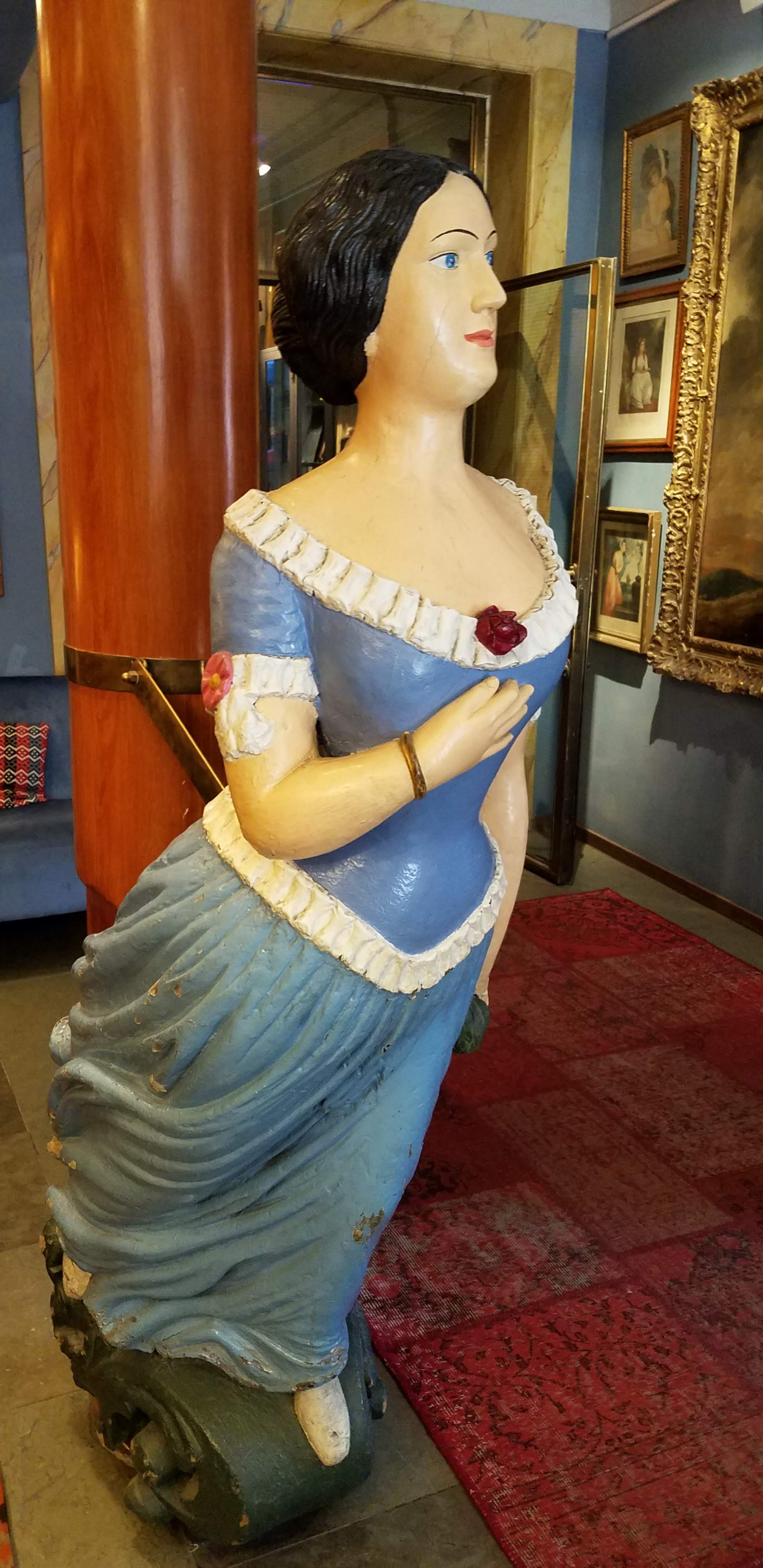
Lady Hamilton figurehead in the hotel lobby
Breakfast at the Lady Hamilton made up for the discomforts we had suffered in our room. First, the eating area was blessedly air conditioned; had we known that last night, our whole group just may have brought our pillows down and slept on the floor under the tables. Then, there was the buffet, which included fresh green apple juice. This was nothing at all like the clear gold liquid we’re all familiar with; it was opaque, pale green, and nothing short of amazing. Other breakfast delights included Swedish pancakes, tiny meatballs, and superior croissants.

Ferry to Djurgården
Our plan for the morning was to visit Djurgården, another island in Stockholm’s archipelago. We arrived at the dock by 8:30 a.m. so we could catch the first ferry, but we soon discovered that because it’s Saturday, the ferry wouldn’t start running until 9:00. No matter.
Our group doesn’t have a hard time figuring out what to do with extra time: we just talk to each other. And as it turned out, we needed that extra half hour to figure out how to operate the ticket-vending machines. Nan and Tony were the first to successfully extract tickets, so they stayed at the kiosks and pressed the complicated series of buttons for each of us in turn.
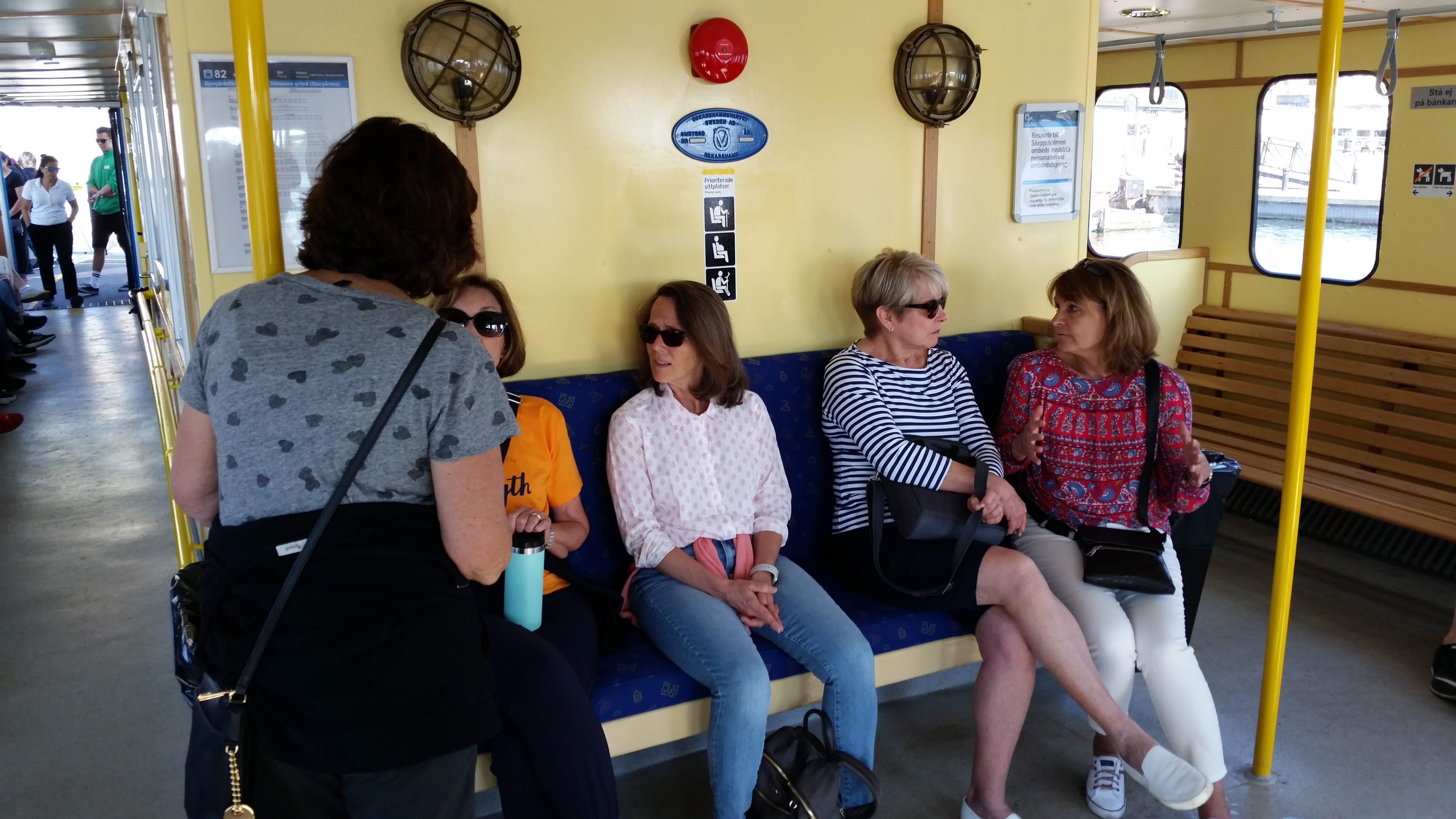
Ladies chilling on the ferry
Djurgården is a popular destination for both tourists and local people because it’s the site of several attractions, including a large amusement park called Gröna Lund (Green Grove), and Skansen, an open-air museum of Swedish history and folklife that also has a zoo. Oh, and the ABBA Museum. As we waited for the ferry, lots of teenagers, mostly girls, began gathering in line behind us. We figured that they probably weren’t headed where we were headed: the Vasa Museum, which displays the remains of the Vasa, a famous warship that sank just outside Stockholm harbor in 1628. Yesterday, Simona had told us that the wooden galleon had been raised in 1961 and painstakingly restored. Unlike most sunken ships, much of the organic material in the Vasa had survived through the centuries because the water in the harbor is not only cold but brackish, meaning that it has a very low salinity level. (The water in the Baltic Sea, which is fed by many large-volume freshwater sources and is only marginally connected to the Atlantic Ocean, has an average salt content of less than 1%. Ocean water averages 3.5% salt.)
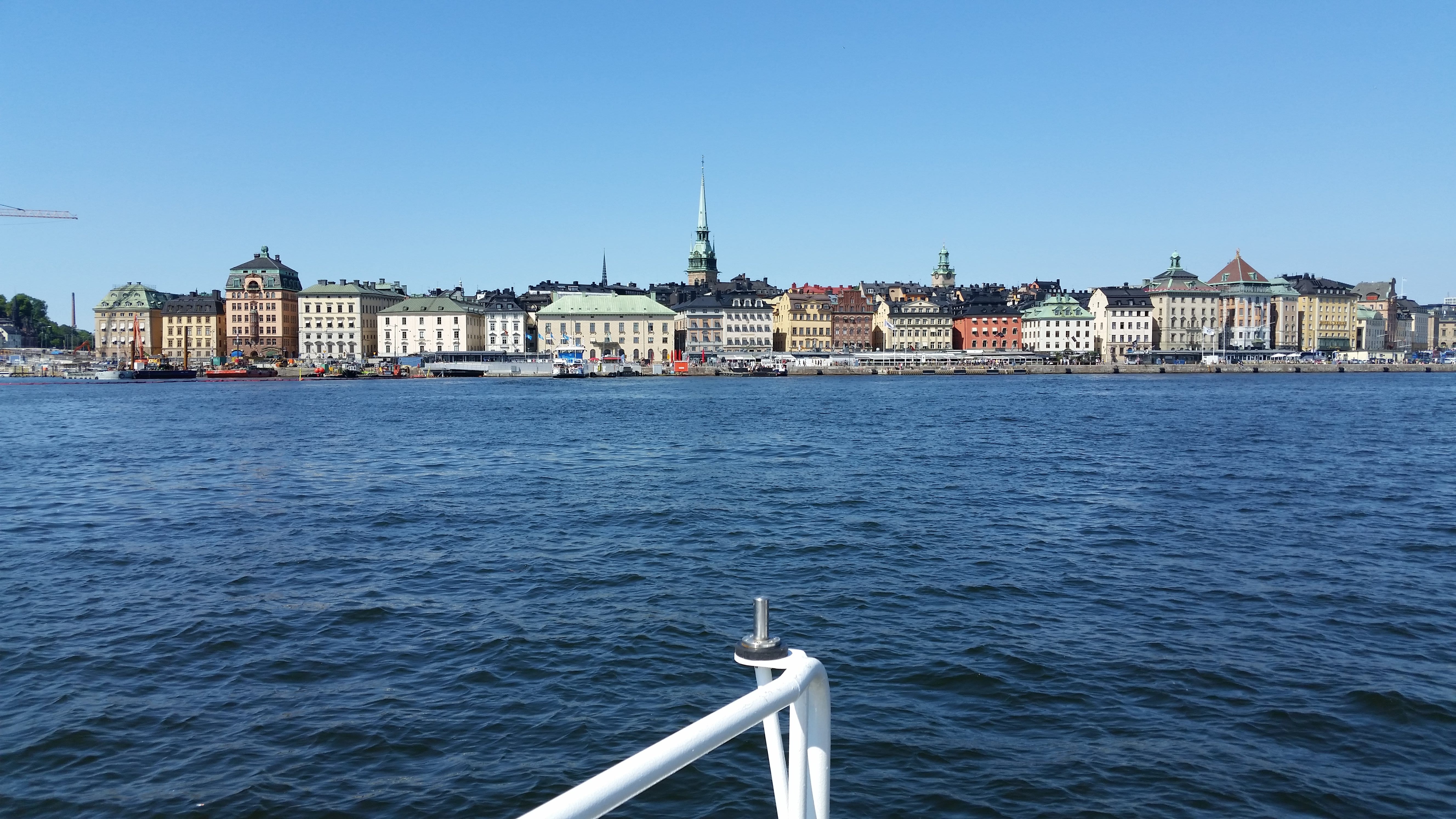
Looking back at Gamla Stan from the ferry
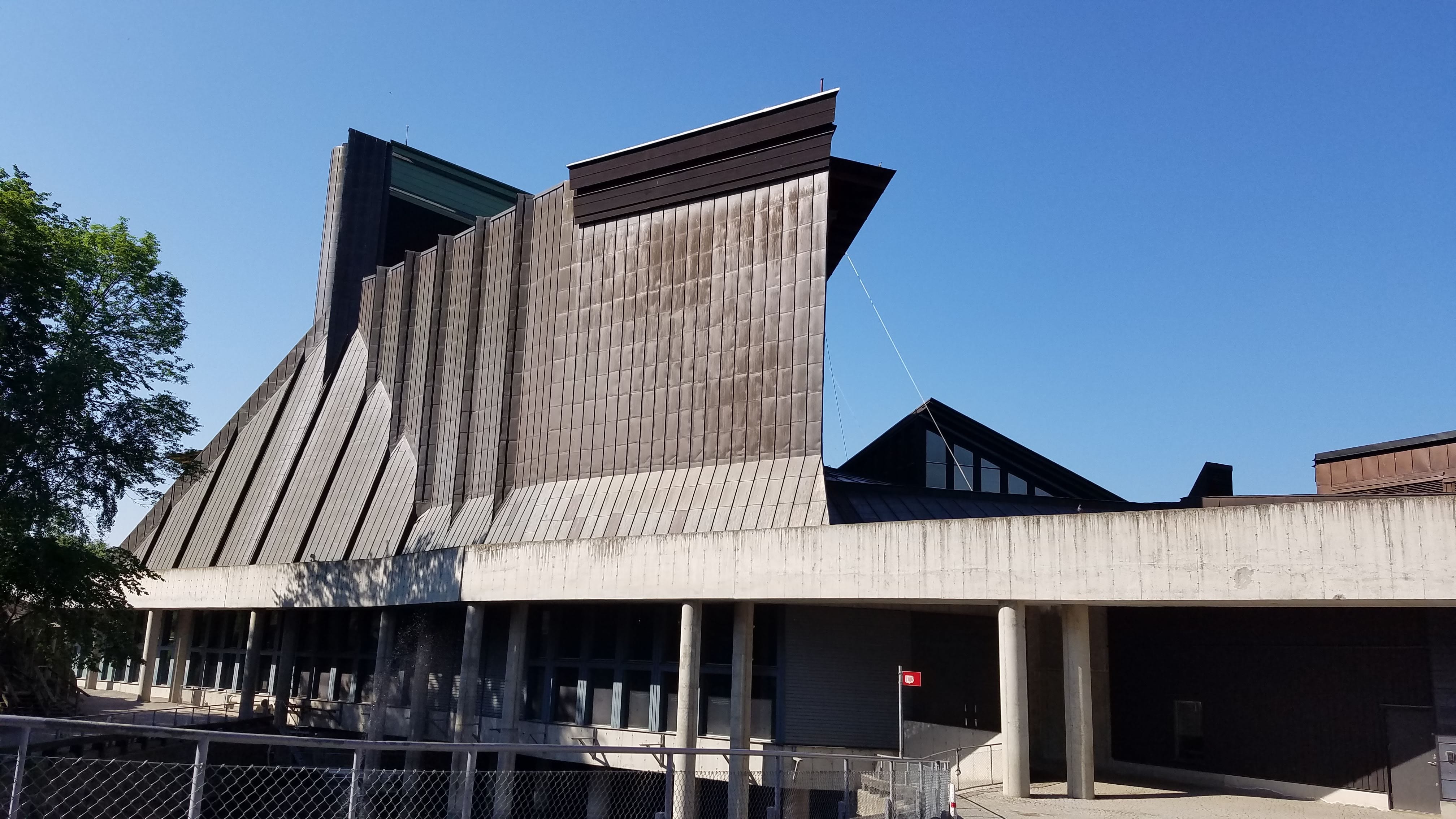
The Vasa Museum stands as tall as the ship’s main mast
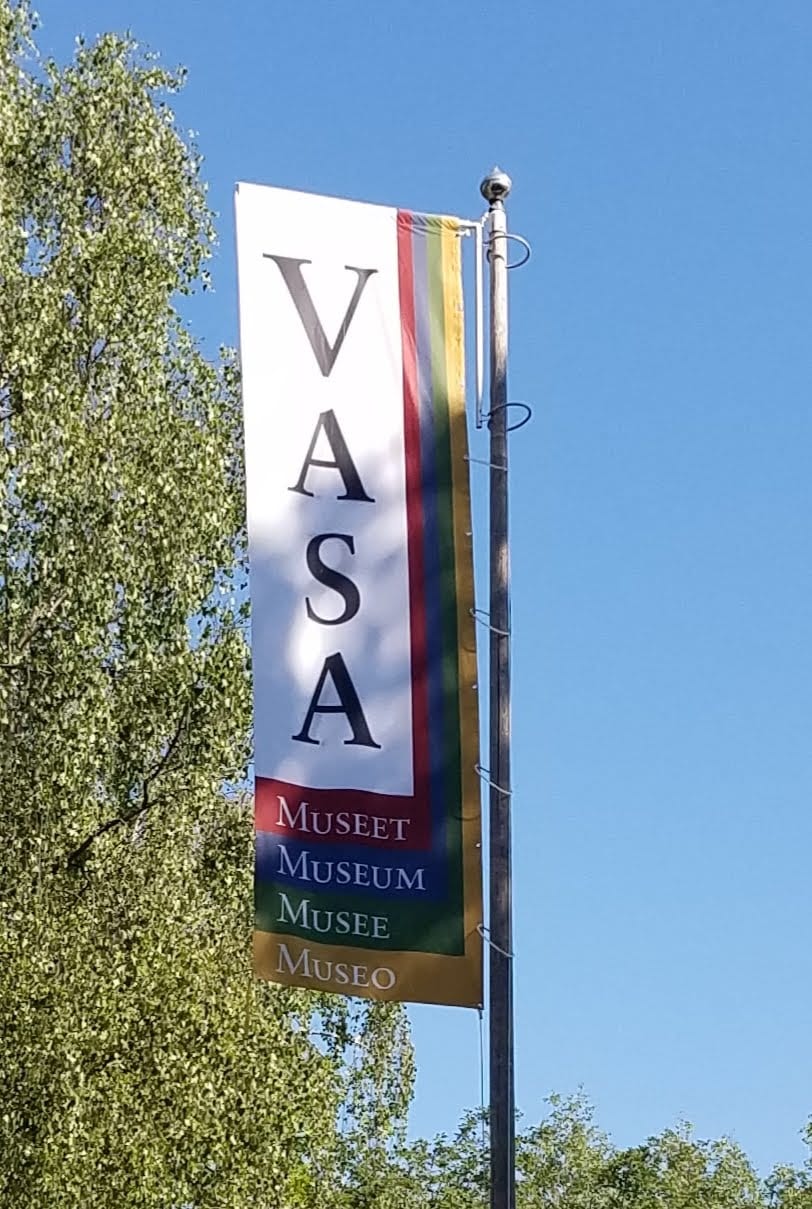
VASA welcome banner
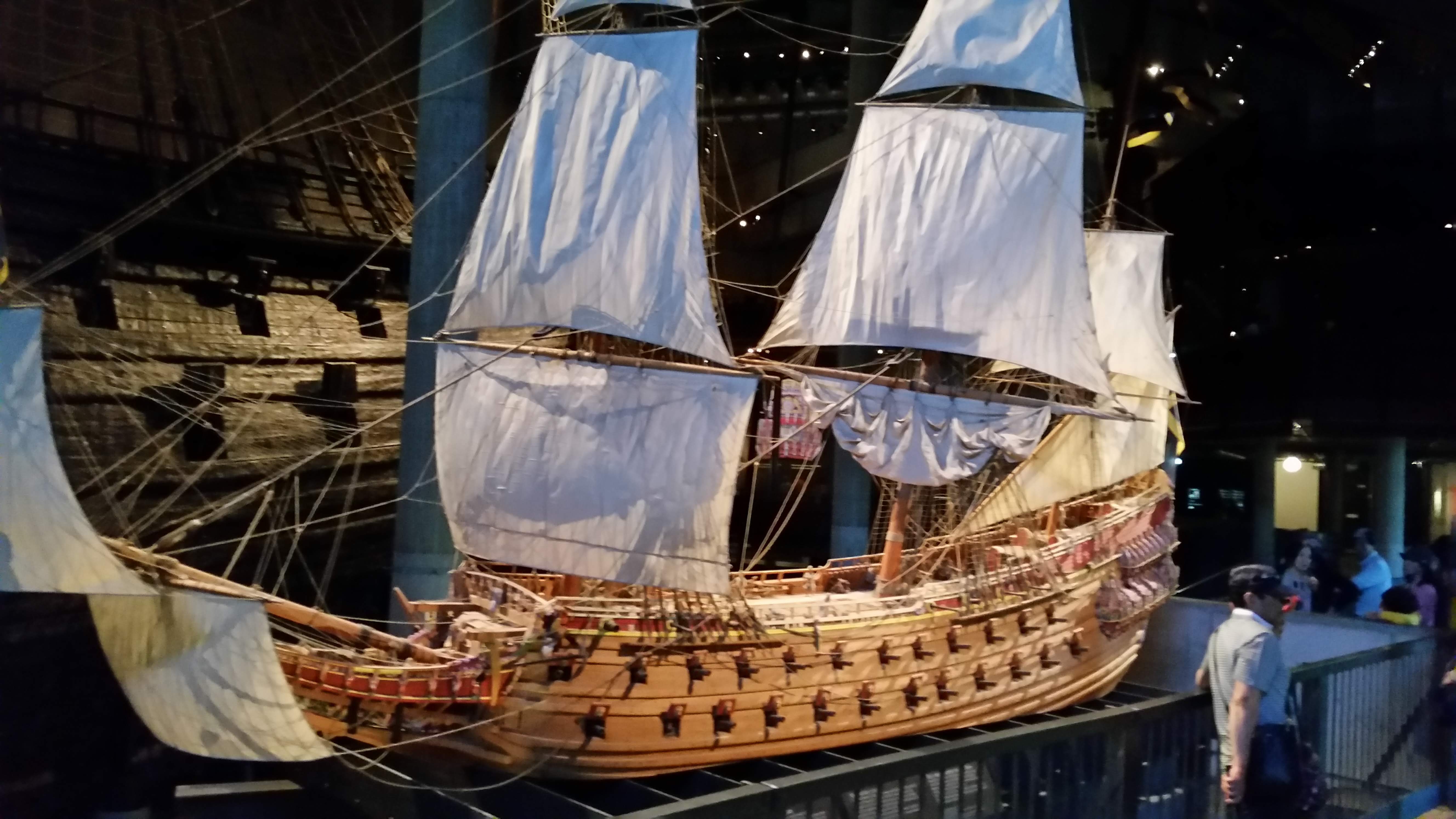
Model of the Vasa, showing the ship in full sail
When the ferry docked, the teenage crowd and most of the other passengers peeled off at the entrance to Gröna Lund, but we continued walking toward the Vasa Museum along a wide avenue lined with souvenir shops and cafes. The museum building is striking, constructed in the 1980s literally around the Vasa after it was brought into dry dock for conservation. We arrived just in time for an English-language tour, conducted by a guide who soon proved to be nearly as fascinating as the history of the ship. This singular person was wearing a skirt and introduced themself as Charlotte, though from the low voice and stubbly chin, we strongly suspected that they probably had been given the name Charles at birth.
Though we may have found Charlotte’s gender confusing, their presentation was straightforward and very informative. We learned that the Vasa had been commissioned in 1626 by King Gustav II Adolph as he sought to extend Sweden’s control of the Baltic, and that he intended the galleon to be the most formidable warship of its day and an emblem of Sweden’s Stormaktstiden (Age of Greatness). As such, the ship was designed to accommodate 72 cannons in two gundecks, and at least 48 of them were capable of projecting a 24-pound ball—twice as heavy as the prevailing standard. At the time, it was more common for naval battles to be decided not on the basis of which combatant managed to sink the other’s ship first, but rather on which side succeeded in boarding the enemy vessel; however, Gustav Adolph favored the use of destructive artillery, and he was the king, so he got his way.
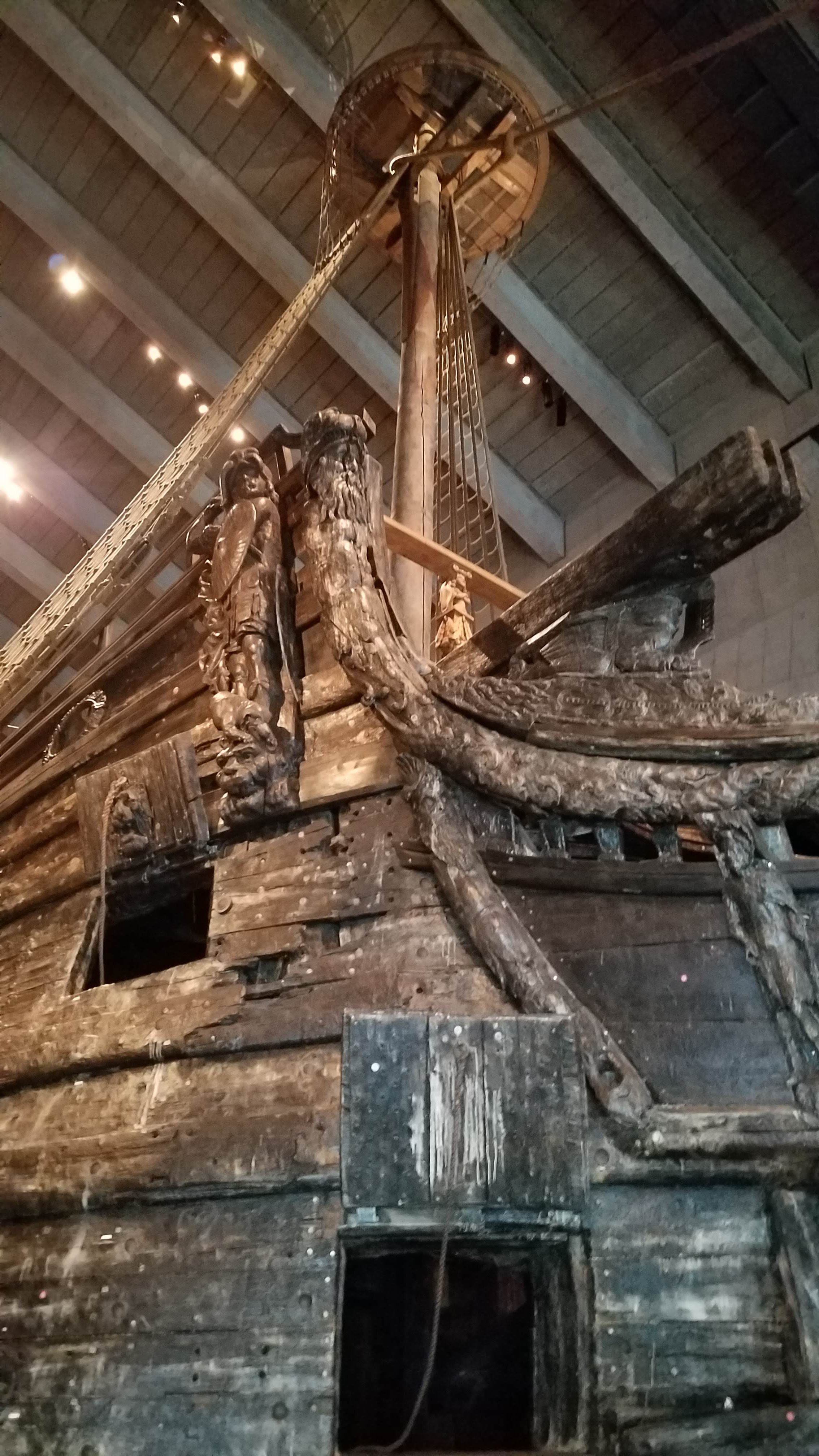
Gunports on the reconstructed ship
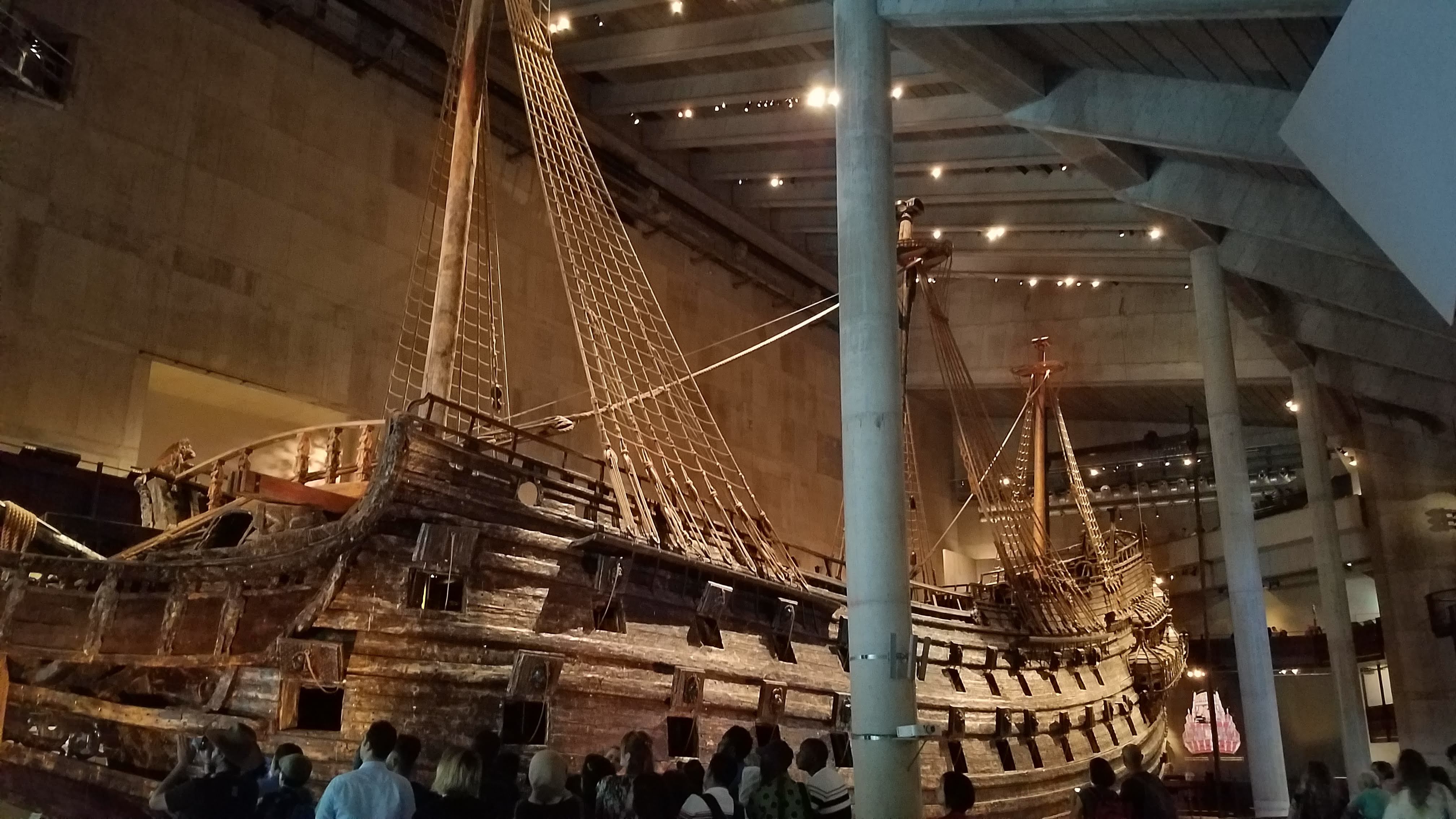
The reconstructed ship includes only the shorter masts, which is how the vessel would have appeared while dry-docked during the winter
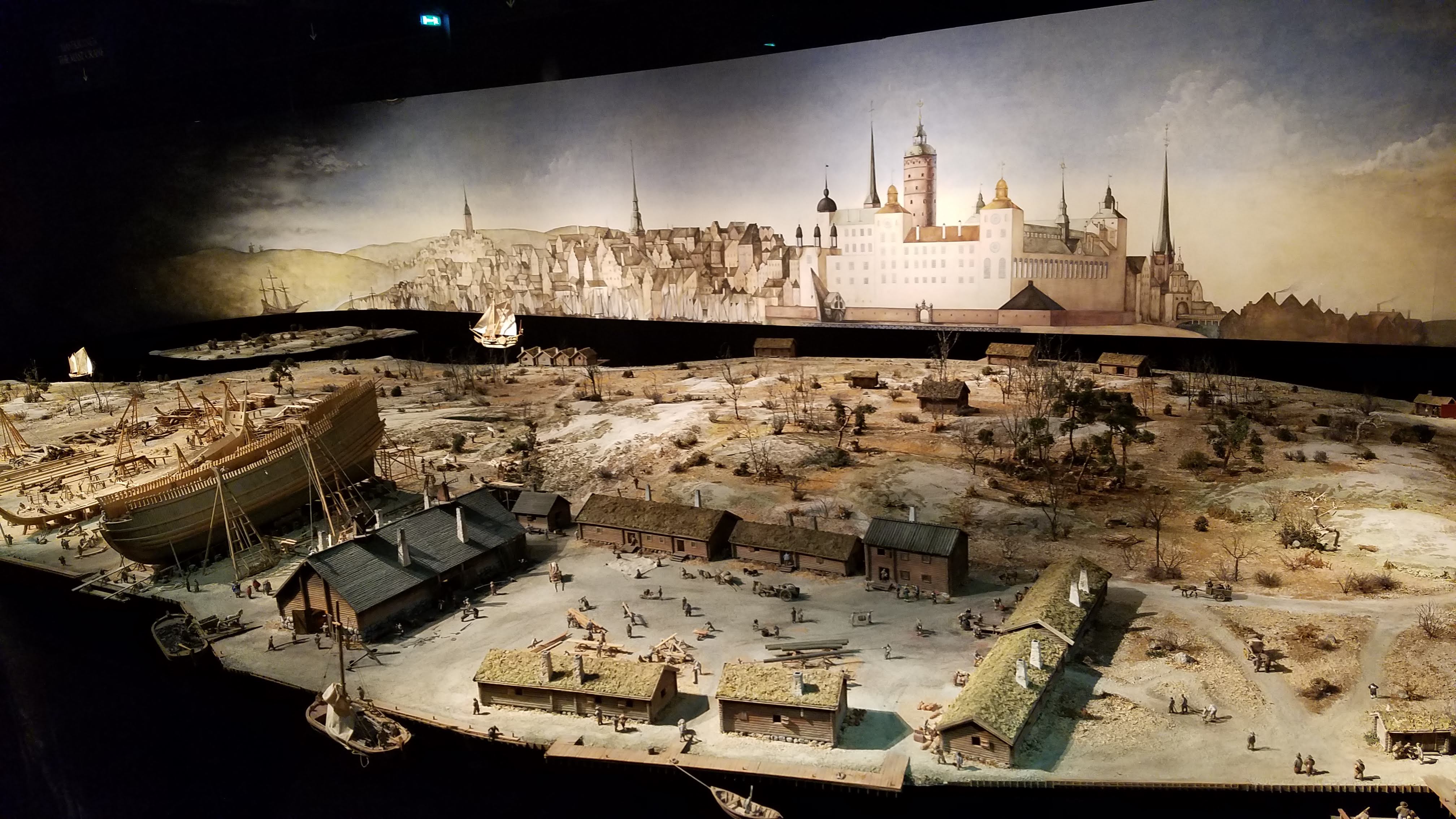
Model of the shipyard where the Vasa was built
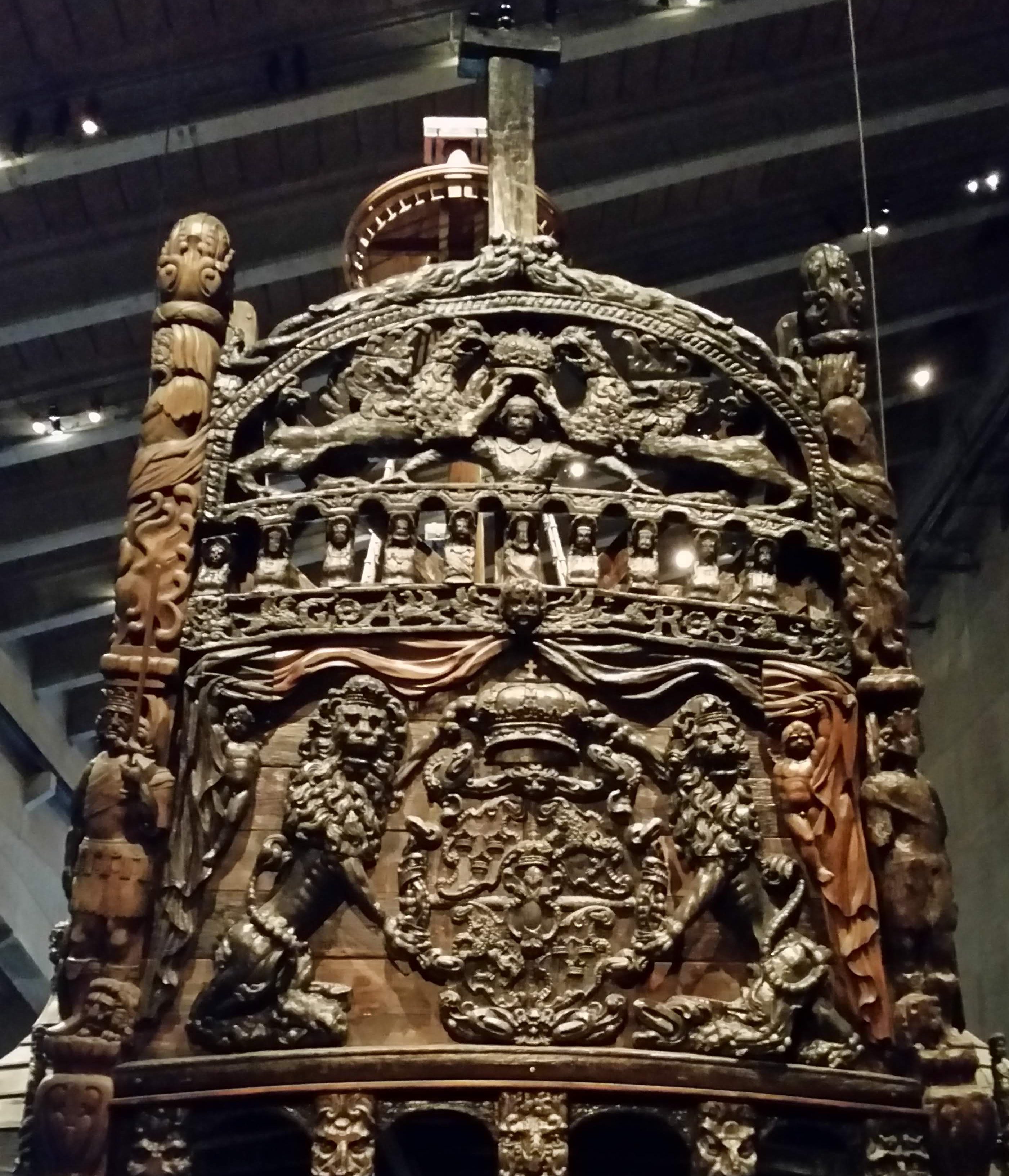
The Vasa was notable not only for its gunnery but also for its size and ornamentation. Elaborately carved and painted with brilliant colors and a lot of gold leaf, the ship must have been a stunning sight on 10 August 1628, the day of its inauguration. Hundreds of people, including many foreign dignitaries, gathered on the waterfront to watch the majestic pageant as the Vasa set sail for the first time.
With its guns fully extended and firing in a ceremonial salute, the vessel started to list even before it had moved out of the harbor. The huge cannons, mounted high above the waterline, rendered the ship dangerously topheavy, so when the wind suddenly picked up and hit the sails broadside, the ship could no longer stay upright and heeled to port. The Vasa began taking on water almost immediately through the open gunports, and within twenty minutes of its launch, the ship sank to the bottom, only 120 meters from shore. Of its 150 crew members, 30 died.
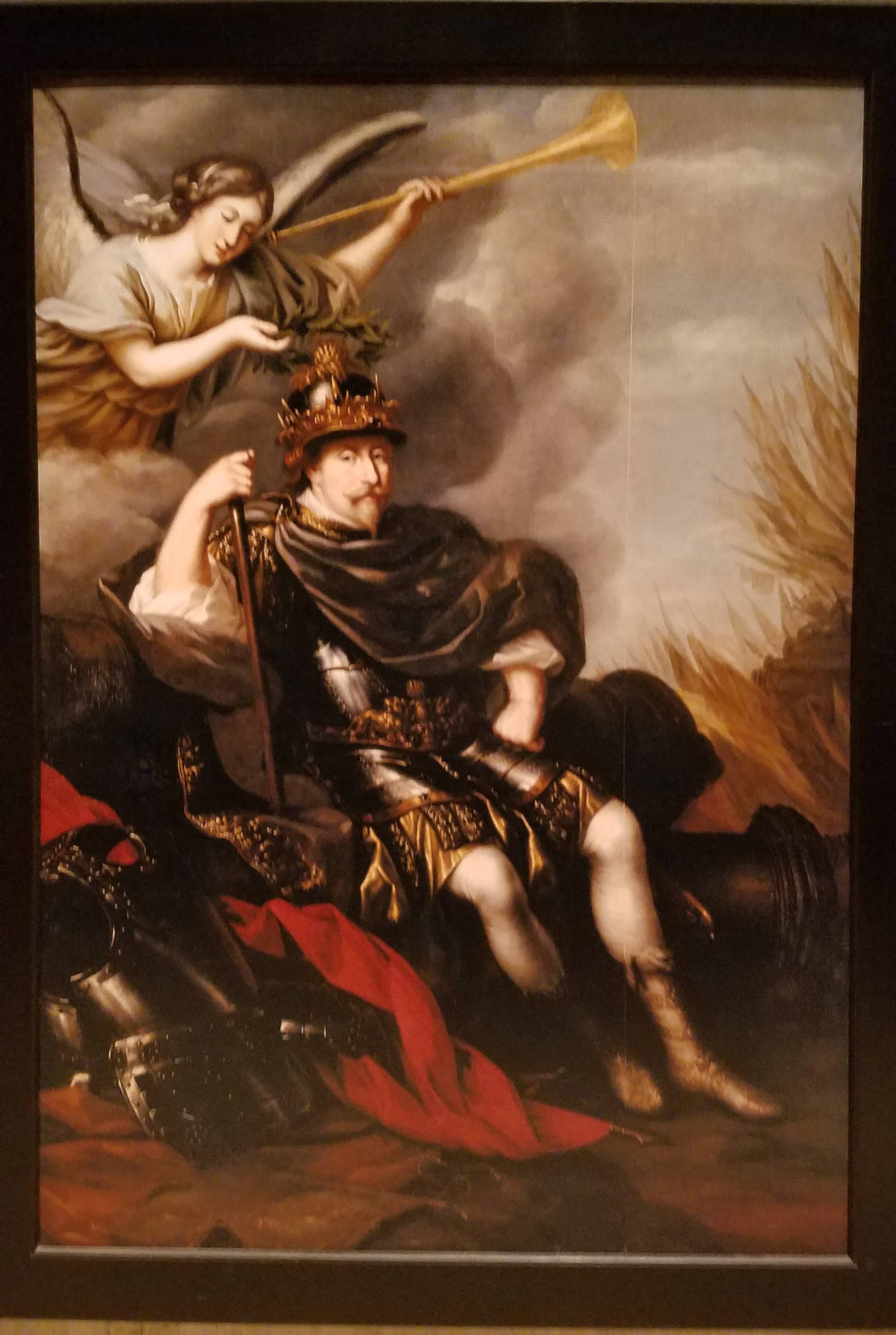
King Gustav II Adolph, commissioner of the Vasa
Initially, an investigation into the disaster focused more on who to blame than on why it happened, but eventually it was determined that because the problem was the ship’s untested, unstable design (which had been approved by the king), and since the designer had died the previous year and the builders had simply followed his instructions, no one could be held accountable. The fiasco did produce some positive results, however: subsequent designs for naval vessels were more thoroughly vetted before production began and, once salvaged, the Vasa and its contents have provided the modern world with a wealth of information about shipbuilding and maritime practices in the seventeenth century.

Cutaway model of the Vasa’s interior illustrates the daily life of a typical crew
Charlotte told us that the water surrounding the Stockholm Archipelago is not very deep, so although the Vasa had hit bottom, its masts protruded up to 20 meters above the waterline and therefore were a hazard for other boats navigating in and out of the port, so they were sawn off and removed soon after the wreck. Over the next few decades, divers salvaged as many valuables as they could, including all of the cannons, but due to technological limitations no attempts were made to raise the ship until the second half of the twentieth century. When the Vasa’s location was pinpointed during the 1950s and divers sent to investigate, everyone was surprised to discover how much of the vessel and its contents had been preserved. We were surprised to learn that while the ship’s iron fittings had completely rusted away, much of the wood and other organic matter had miraculously survived. Linen clothing and leather shoes were still recognizable when they were exhumed from the mud, and the bodies of some of the drowned crew members even had pieces of flesh clinging to the bones. When the hull was finally raised in 1961, at least as many people gathered along the waterfront to watch as had witnessed the ship’s sinking 333 years earlier—and that doesn’t include the television audience.

Nan guiding Michael through buying a ticket at the kiosk
We were glad that we had arrived at the Vasa Museum early this morning, because by the time we left about 10:45 a.m. the place had been overwhelmed by hordes of tourists. We hurried back to the dock, where Nan and Tony again shepherded everyone through the ticket kiosks so we could pay our fare for the return ferry trip.
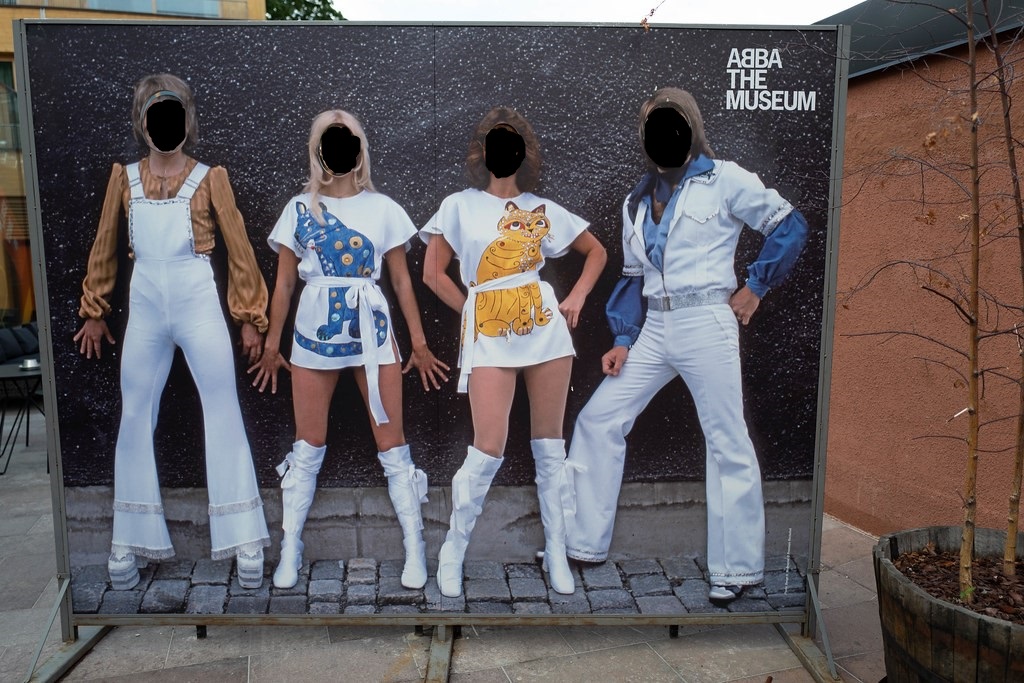
We didn’t have time to stop at the ABBA Museum and take our own photos here, so you’ll just have to imagine the faces of NJ, Mary-Anne, Katie, and Tony on these famous figures
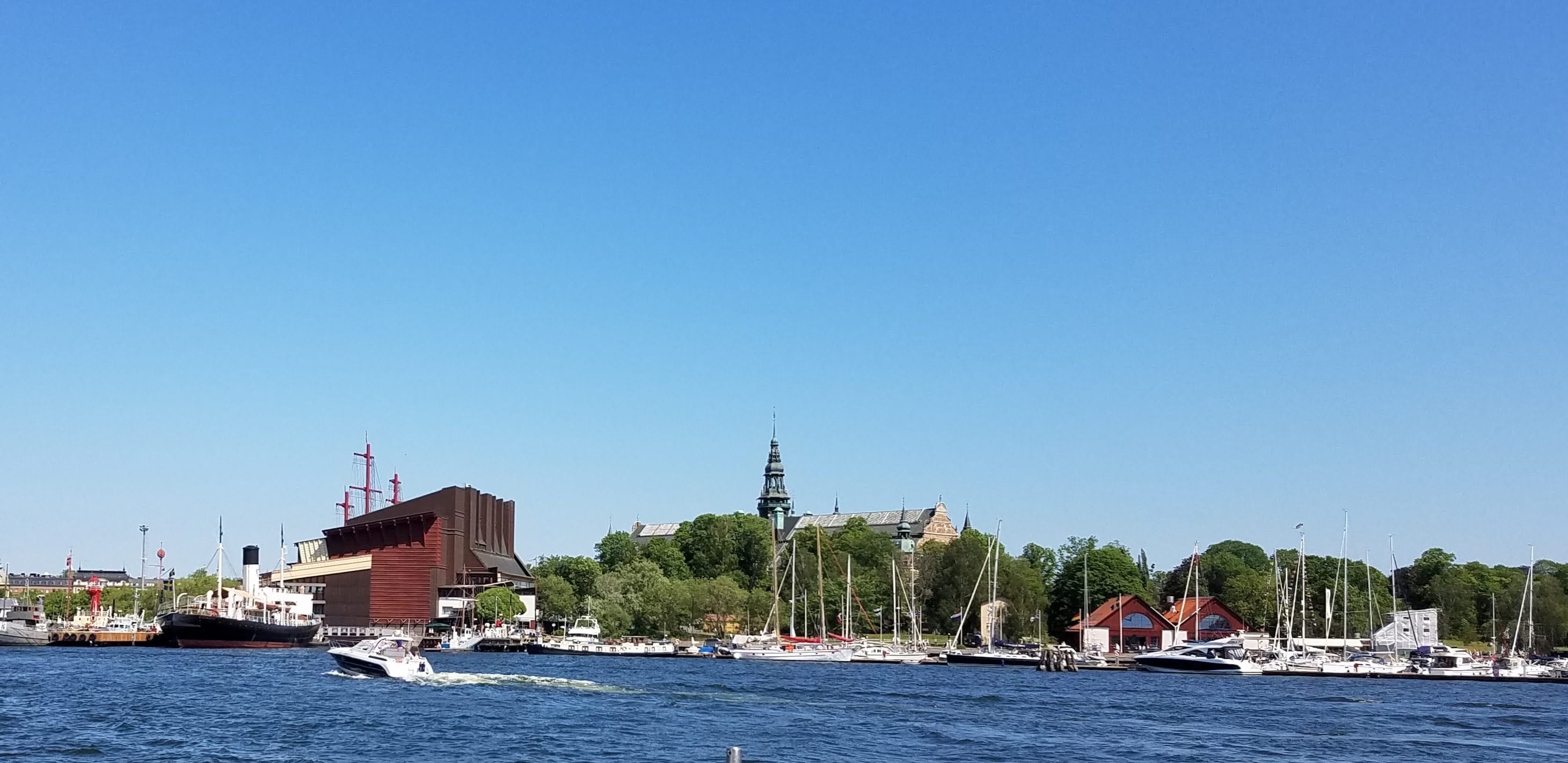
What looks like a cathedral from the ferry looking back at Djurgården is the Nordic Museum
Back on Gamla Stan so we could retrieve our luggage from the hotel, Nancy and Michael took a slight detour. We were searching for cardamom buns, which Simona had recommended as a Swedish delight not to be missed. “They’re like cinnamon rolls,” she said, “but not as sweet, and of course, the flavoring is different.” When we asked her where we should look for them, she said that just about any bakery or cafe would have them. Because we were now in a hurry, we stopped at a sidewalk cafe on the way to the hotel and inquired whether they sold them.
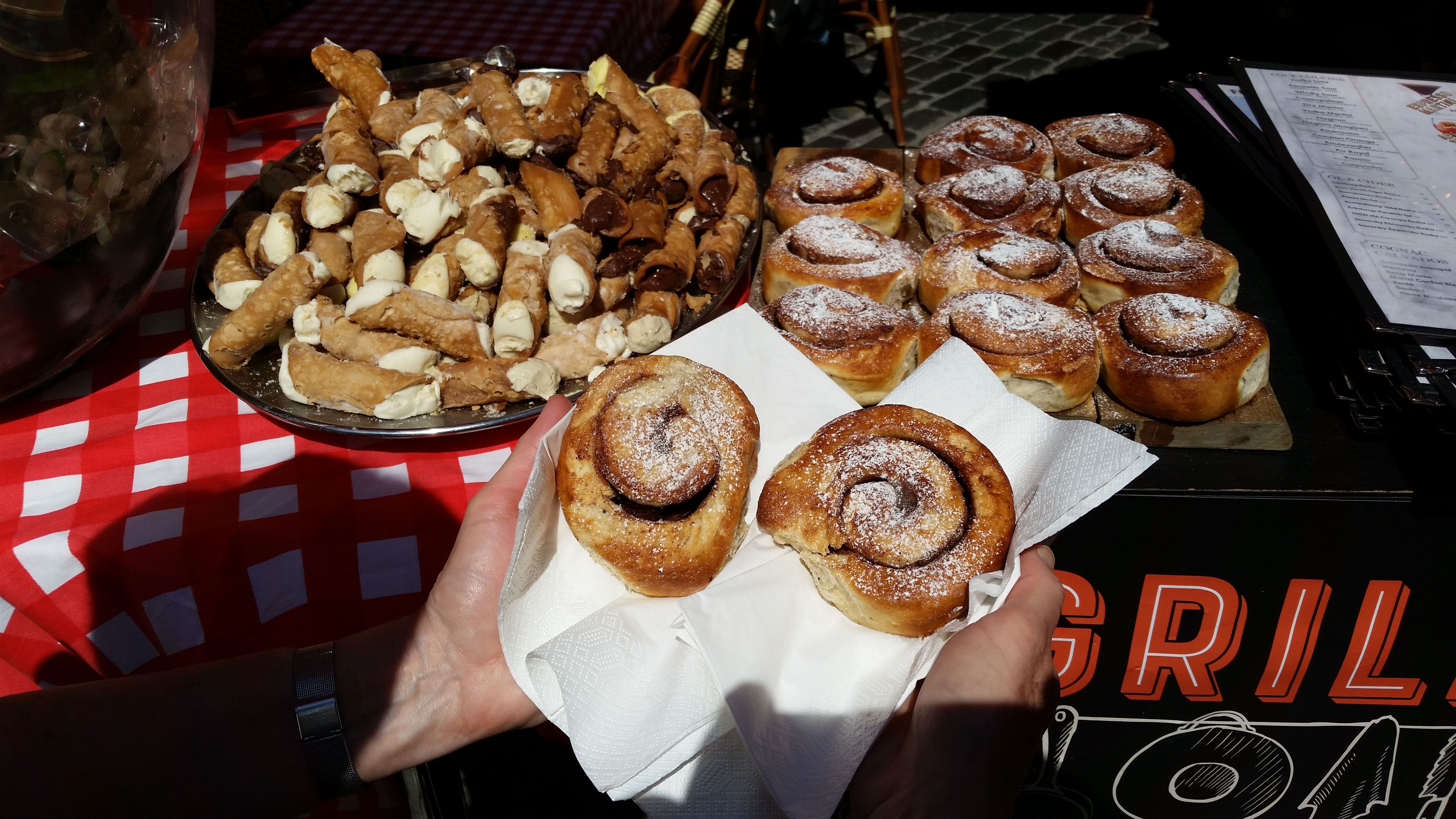
Cardamon buns? Not
“Cardamom buns?” asked the host. “You mean like these?” He pointed at some delicious-looking round pastries on a tray next to the posted menu.
“If those are cardamom buns,” we said, “then we’d like two, to take away.”
After we had paid and were hurrying toward the hotel, we took a couple of bites and decided that although they were good, what we had bought were just regular cinnamon rolls. (Later we calculated that those rolls had cost about $15—each. As Nancy’s mother would have said, “Live and learn.”)
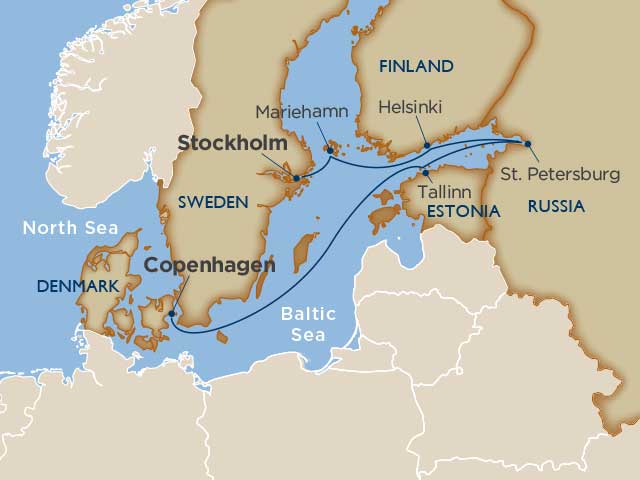
Our itinerary
By the time we collected our luggage, checked out of the hotel, and walked back to the spot where the bus had left us the day before, it was 12:15 pm. Soon we were on our way to the cruise ship port on the northeast side of Stockholm, about 5 kilometres away. Carol and Jim always make sure to leave plenty of cushion time when we have a deadline to meet, so we arrived at the cruise terminal early and had to wait about twenty minutes before we were allowed to board the Star Breeze. While chatting with a couple in line behind us, we learned that at one time they had lived only a few miles from us in Cincinnati, but our paths had never crossed until now.
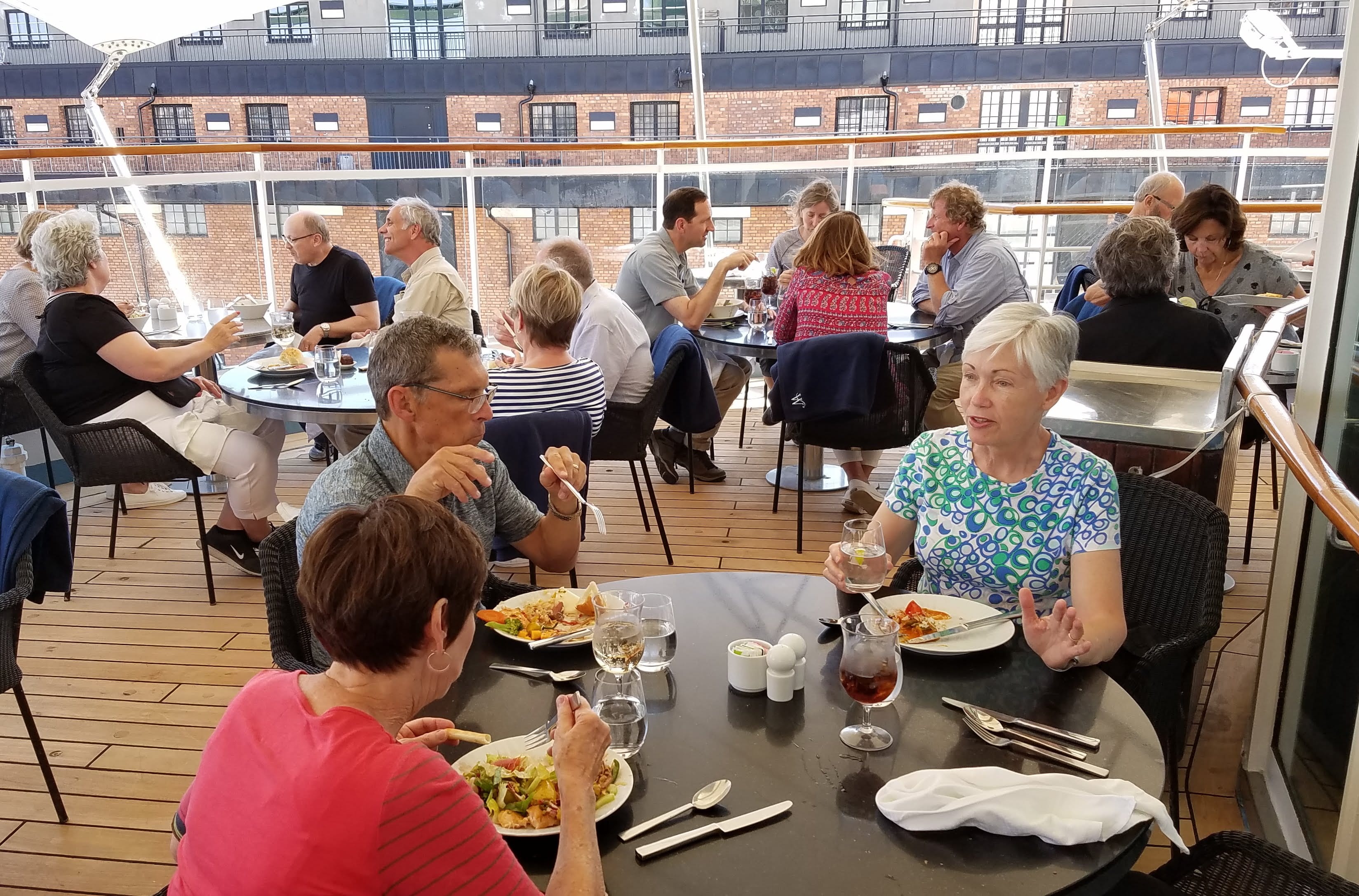
Lunch on the Veranda with Nan and Keith
Once we checked in, we went immediately to the Veranda deck for the lunch buffet. Michael assembled a plate of greens and vegetables from the salad bar, adding strips of beef tenderloin from the carving board. Nancy also made herself a salad, but bypassed the tenderloin in favor of the chicken cacciatore. Nancy and Linda were thrilled to see bread pudding and vanilla sauce in a warmer on the dessert table; the peerless bread pudding served daily for lunch on the Wind Star, the ship that had taken us on our 2017 Aegean cruise, had been a highlight of that trip. Today’s pudding had melty chocolate chips scattered through it, which made up for the fact that the vanilla sauce was not as rich and buttery as what we remembered from the other ship. It was fun to hear a lot of laughter emanating from the table where NJ, Mary-Anne, Tony, and Katie were sitting. Most of us had not seen NJ and Mary-Anne for at least a few years, and all of us had looked forward to hearing the latest in their seemingly endless supply of amusing stories.
After lunch, we went back to our cabins to unpack the luggage that porters had deposited there while we ate. Almost as soon as Michael noticed that his large suitcase was missing, our phone rang. It was a security officer, requesting that Michael come upstairs to claim the bag. Was this about the Swiss Army knife he had packed? Yes, it was. The knife had not been confiscated, but the security officer just wanted to warn him to not take it into Russia when we got there.

Our very comfortable stateroom
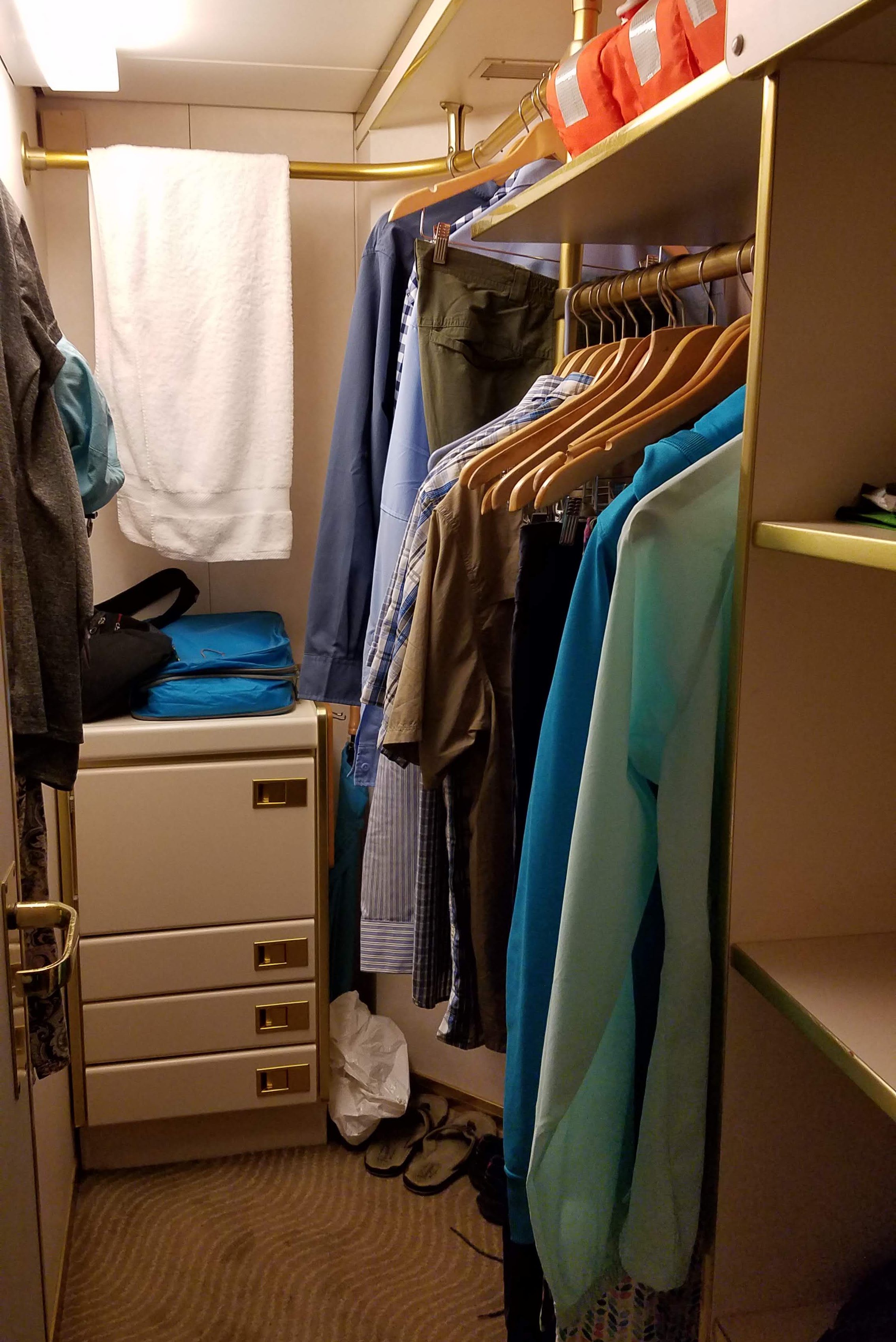
Walk-in closet
Our suite is surprisingly large and comfortable. We have a king-size bed with a small nightstand on each side, and a desk/dresser along the opposite wall. Next to the door to the corridor is a walk-in closet, and next to that a bathroom that’s big enough for two people to occupy at the same time, with a toilet, two sinks, a combination tub/shower, a storage cabinet, and mirrors that are situated such that you can see your entire body, both front and back, without turning your head. A curtain in the middle of the suite can be pulled closed to separate the bedroom area from sitting area, which includes a bar and refrigerator, an entertainment center, a couch, two armchairs, and a coffee table. A 4-foot by 6-foot window gives us a great view of the passing scenery. Knowing that this is to be our home-away-from-home for a week, we completely unloaded our baggage, filling the drawers, hanging clothes in the closet, and stowing the empty suitcases under the bed.
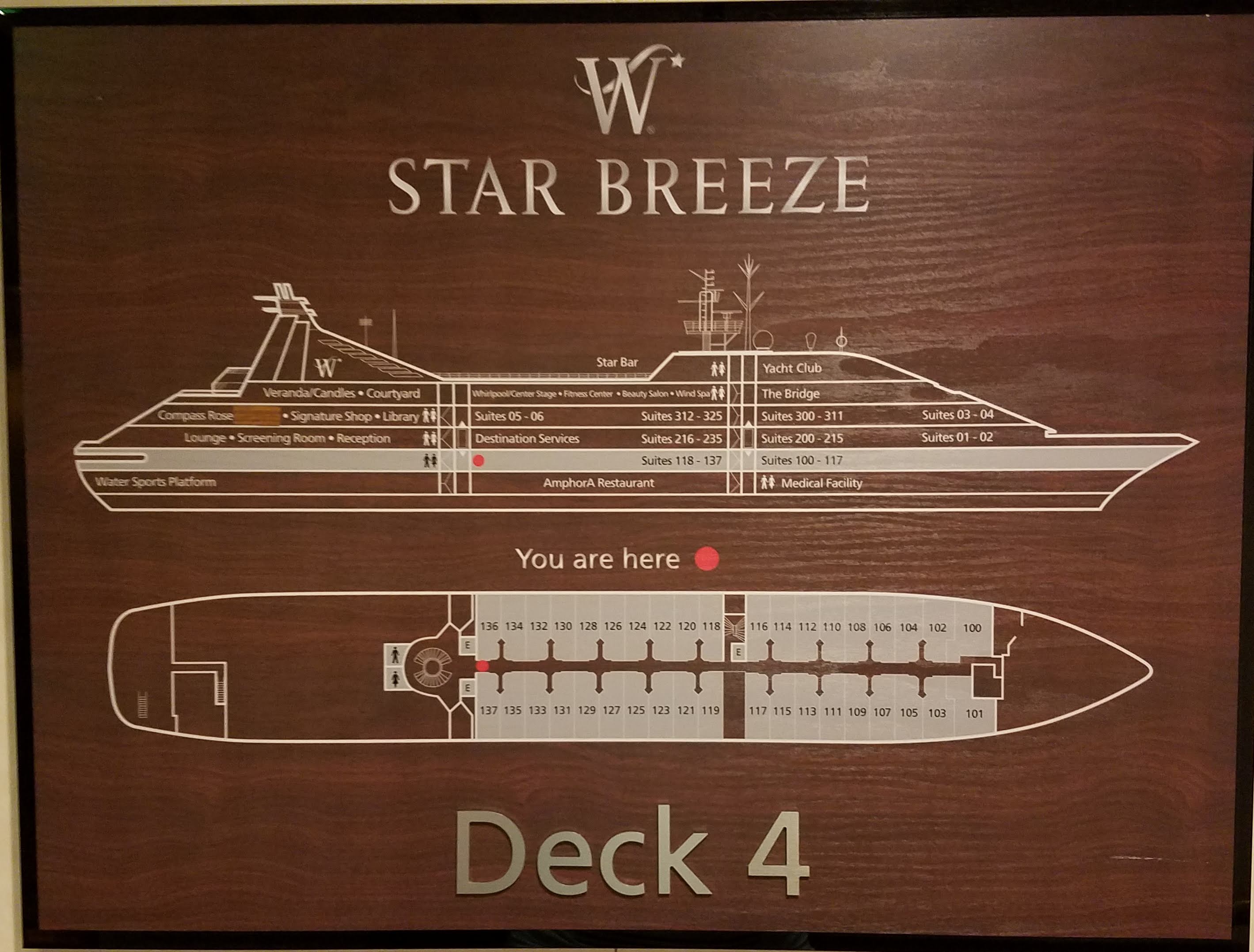
Plan of the ship
Once we had unpacked, we set out to explore the boat. The Star Breeze has eight levels, with cabins for its 200 guests on Levels 4-6. Our group occupies the cabins at the stern end of Level 4; the dock entrance/exit and business offices are also on that level. Besides the guest rooms on Level 5, there are a reception area, a small screening room for movies, and an auditorium. Level 6 has a gift shop, a library, and a lounge/bar in addition to guest rooms. The bridge is at the stern on Level 7, along with the spa, fitness room, and salon. Midship on Level 7 is an open deck area with a hot tub and a small counter-current pool; the aft end holds the buffet area where we have breakfast and lunch, with both indoor and outdoor seating. The Yacht Club, where one can play games, order a drink, get a sandwich, or grab a snack at any hour, is on Level 8. AmphorA, the large dining room where dinner is served, is on Level 3, along with the medical center, kitchen, and laundry. Presumably, the crew’s quarters, engine rooms, and a lot of stuff we can’t even imagine are on Levels 1 and 2.
Nancy was eager to find the salon and make an appointment for a haircut on Thursday, the one full day we will be at sea, since it has been more than three weeks since her last trim. Michael decided to use the sizable onboard-services credit that each of us had received for a massage, taking advantage of a launch-day special that added fifteen extra minutes to the usual session.
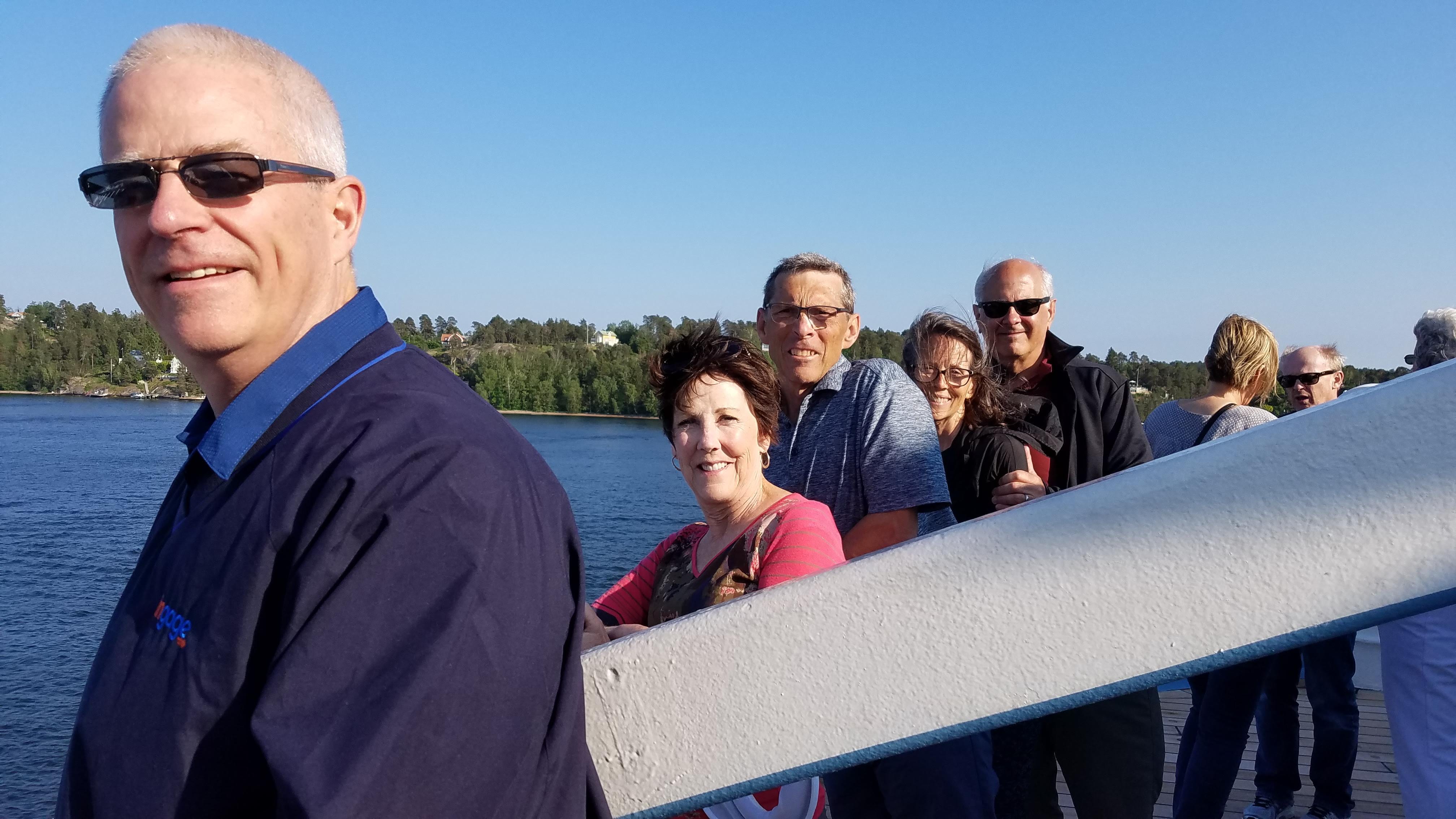
“Sailing” away
At 4:15 p.m., everyone on board filed to our assigned assembly areas for a mandatory safety drill. We practiced putting on our life jackets and received further instructions about what to do in the event of an emergency, and then returned to our rooms only long enough to put away the life jackets so we could be back on deck at 5:00 for the “Sail Away” ceremony. On the Wind Star, this had involved unfurling the sails, but since the Star Breeze operates entirely by diesel engines, today’s ceremony lacked the same drama.

Passage through the Stockholm Archipelago
On the other hand, our passage through the Stockholm Archipelago was captivating—especially as seen from our cabin window, which was just above the water line. The ship had to navigate around literally hundreds of islets, most covered with evergreen trees, others dotted with homes and outbuildings, and many tiny ones that were hardly more than clusters of bare rock. One that was maybe twenty meters long featured two trees filled with roosting cormorants. (We really regret that we were moving too fast to get a photo of that.) We didn’t reach open sea until much later this evening. Michael surmises that this is what cruising from Vancouver to Juneau must look like.
Just before 6:00, Michael headed to the spa for his massage, while Nancy went to the auditorium to find out whether her name would be chosen in a drawing to win complimentary spa or salon services. One had to be present to win, so Nancy endured the entire program of promotional speeches and lame jokes hoping that her name would be pulled from the basket but, alas, it never was. However, she was there to hear the names of Nan, Katie, Pam, Mary-Anne, and Linda called out by the spa services manager, but only Linda was there at the right time to claim her prize: a free manicure.
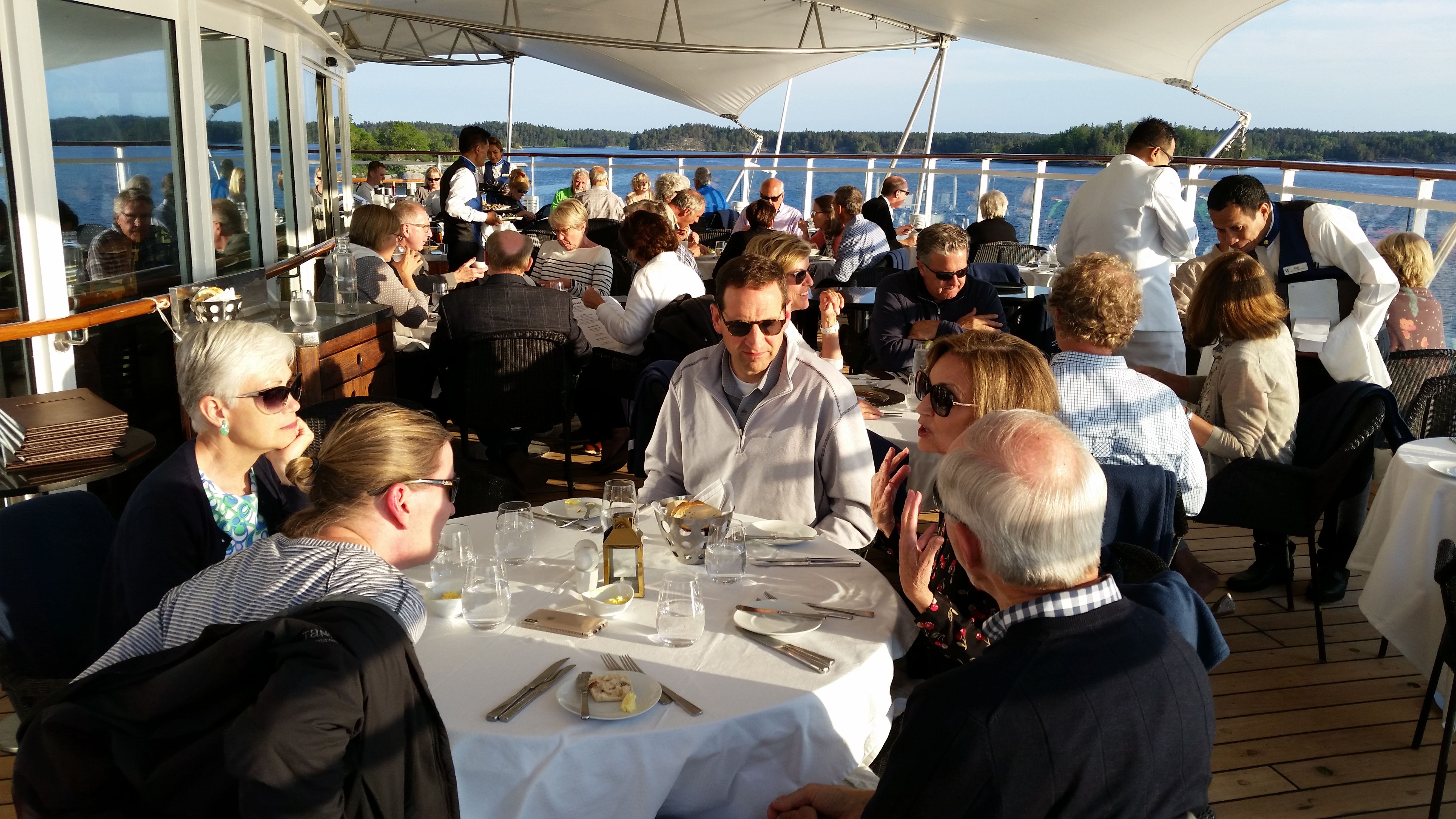
Dinner at the Candles Grill, aka the Veranda, with Ed, Linda, Budge and Lisa
At 7:30, we climbed the spiral staircase to Level 7 to meet our group at the outdoor dining area, which had been transformed into the Candles Grill for the evening. Seating at Candles is by reservation only, but Jim and Carol had had the foresight to reserve tables for our whole group on this lovely, warm evening.
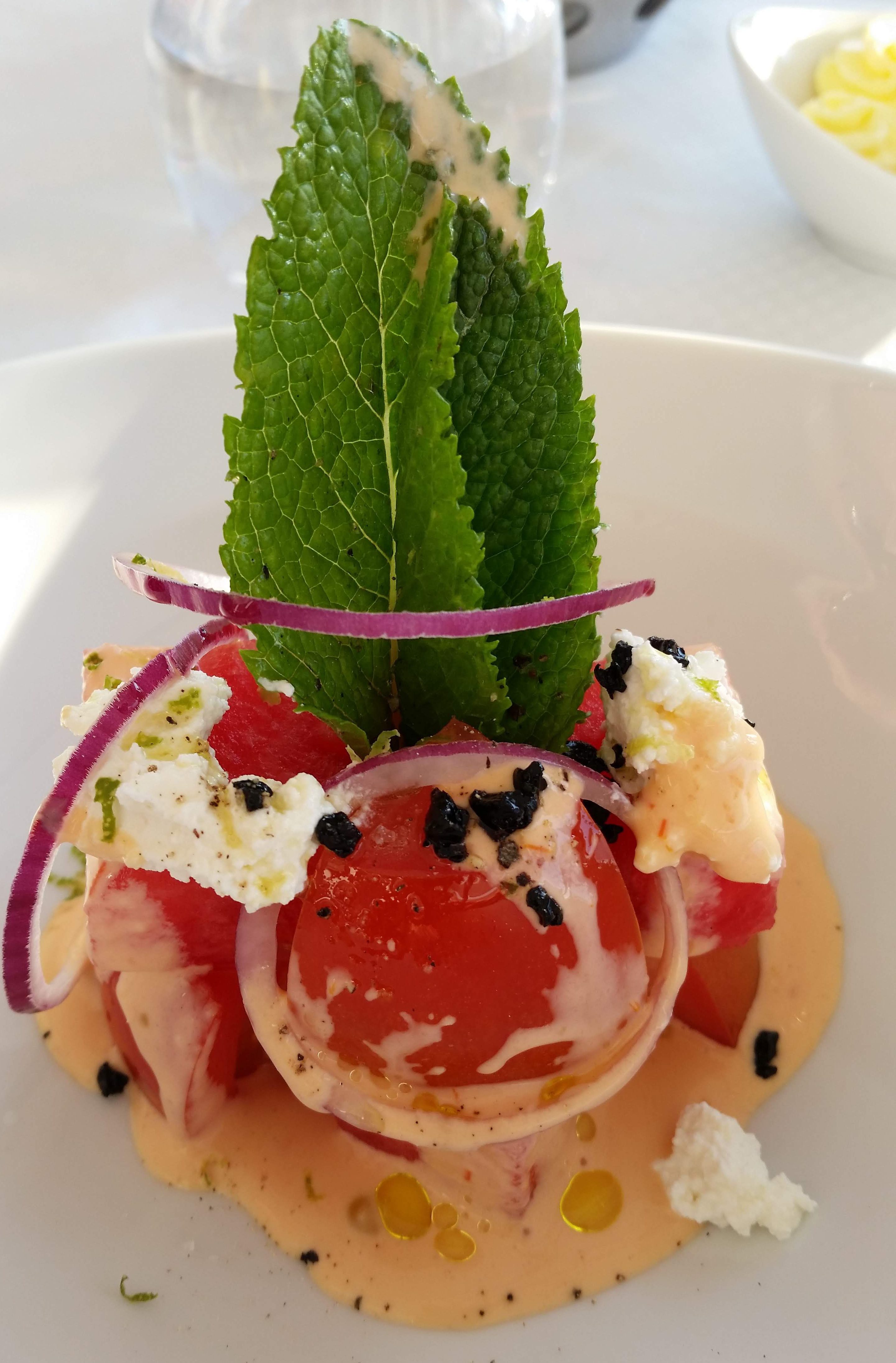
Tonight’s appetizer: tomato stuffed with crab salad
Everything on the Candles menu comes from the grill; Michael ordered the veal chop and Nancy the tuna fillet. With our tablemates Ed, Lisa, Budge, and Linda, we shared sides of asparagus, broccolini, mushrooms, and little potatoes, all served family-style. Nancy was dismayed that although she had ordered her tuna medium-rare, it was white all the way through and rather dry, but the rest of the meal was good. For dessert she had a lemon tart; Michael had crème brulée with a layer of chocolate on the bottom.
We didn’t feel the ship rock very much during the evening, so although neither of us had prepared for possible seasickness with pills or patches the way some of our group had, we didn’t have any problems. We tried to go to bed as soon as we could, but because we would be entering the Eastern European time zone during the night, we had to set our clocks an hour ahead before retiring. They read 11:30 p.m. when we turned off the lights.
Awesome storytelling, Michael and Nancy! I loved reading about Vasa again as some of details got lost deep in my memory 🙂 We visited Stockholm briefly a few years ago and really enjoyed our time there. Can’t wait to go back! Keep sharing please….